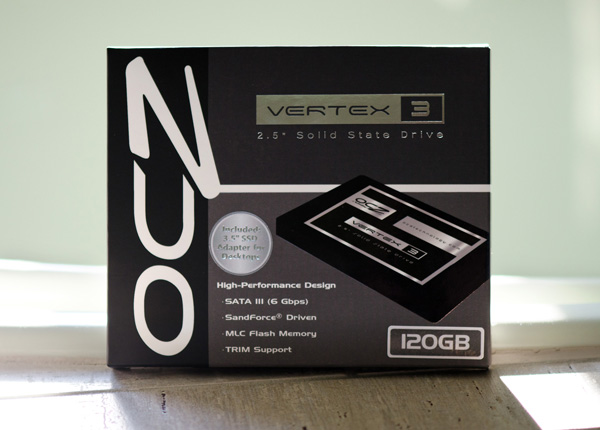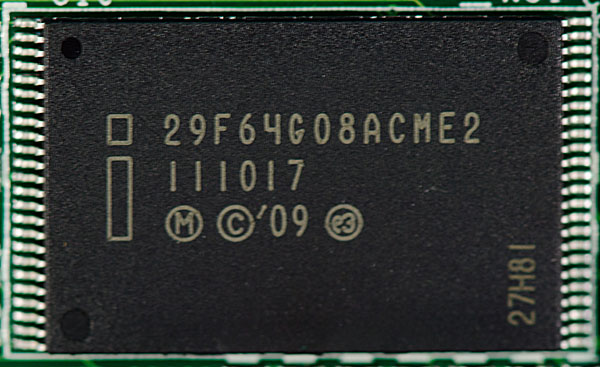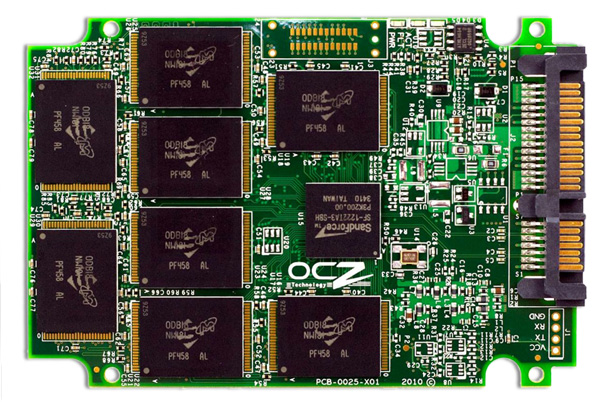The OCZ Vertex 3 Review (120GB)
by Anand Lal Shimpi on April 6, 2011 6:32 PM ESTSandForce was first to announce and preview its 2011 SSD controller technology. We first talked about the controller late last year, got a sneak peak at its performance this year at CES and then just a couple of months ago brought you a performance preview based on pre-production hardware and firmware from OCZ. Although the Vertex 3 shipment target was originally scheduled for March, thanks to a lot of testing and four new firmware revisions since I previewed the drive, the officially release got pushed back to April.
What I have in my hands is retail 120GB Vertex 3 with what OCZ is calling its final, production worthy client firmware. The Vertex 3 Pro has been pushed back a bit as the controller/firmware still have to make it through more testing and validation.
I'll get to the 120GB Vertex 3 and how its performance differs from the 240GB drive we previewed not too long ago, but first there are a few somewhat-related issues I have to get off my chest.
The Spectek Issue
Last month I wrote that OCZ had grown up after announcing the acquisition of Indilinx, a SSD controller manufacturer that was quite popular in 2009. The Indilinx deal has now officially closed and OCZ is the proud owner of the controller company for a relatively paltry $32M in OCZ stock.
The Indilinx acquisition doesn't mean much for OCZ today, however in the long run it should give OCZ at least a fighting chance at being a player in the SSD space. Keep in mind that OCZ is now fighting a battle on two fronts. Above OCZ in the chain are companies like Intel, Micron and Samsung. These are all companies with their own foundries and either produce the NAND that goes into their SSDs or the controllers as well. Below OCZ are companies like Corsair, G.Skill, Patriot and OWC. These are more of OCZ's traditional competitors, mostly acting as assembly houses or just rebadging OEM drives (Corsair is a recent exception as it has its own firmware/controller combination with the P3 series).
By acquiring Indilinx OCZ takes one more step up the ladder towards the Intel/Micron/Samsung group. Unfortunately at that level, there's a new problem: NAND supply.
NAND Flash is not unlike any other commodity. Its price is subject to variation based on a myriad of factors. If you control the fabs, then you generally have a good idea of what's coming. There's still a great deal of volatility even for a fab owner, process technologies are very difficult to roll out and there is always the risk of issues in manufacturing, but generally speaking you've got a better chance of supply and controlled costs if you're making the NAND. If you don't control the fabs, you're at their mercy. While buying Indilinx gave OCZ the ability to be independent of any controller maker if it wanted to, OCZ is still at the mercy of the NAND manufacturers.
Currently OCZ ships drives with NAND from four different companies: Intel, Micron, Spectek and Hynix. The Intel and Micron stuff is available in both 34nm and 25nm flavors, Spectek is strictly 34nm and Hynix is 32nm.
Each NAND supplier has its own list of parts with their own list of specifications. While they're generally comparable in terms of reliability and performance, there is some variance not just on the NAND side but how controllers interact with the aforementioned NAND.
Approximately 90% of what OCZ ships in the Vertex 2 and 3 is using Intel or Micron NAND. Those two tend to be the most interchangeable as they physically come from the same plant. Intel/Micron have also been on the forefront of driving new process technologies so it makes sense to ship as much of that stuff as you can given the promise of lower costs.
Last month OWC published a blog accusing OCZ of shipping inferior NAND on the Vertex 2. OWC requested a drive from OCZ and it was built using 34nm Spectek NAND. Spectek, for those of you who aren't familiar, is a subsidiary of Micron (much like Crucial is a subsidiary of Micron). IMFT manufactures the NAND, the Micron side of it takes and packages it - some of it is used or sold by Micron, some of it is "sold" to Crucial and some of it is "sold" to Spectek. Only Spectek adds its own branding to the NAND.
OWC published this photo of the NAND used in their Vertex 2 sample:
I don't know the cause of the bad blood between OWC and OCZ nor do I believe it's relevant. What I do know is the following:
The 34nm Spectek parts pictured above are rated at 3000 program/erase cycles. I've already established that 3000 cycles is more than enough for a desktop workload with a reasonably smart controller. Given the extremely low write amplification I've measured on SandForce drives, I don't believe 3000 cycles is an issue. It's also worth noting that 3000 cycles is at the lower end for what's industry standard for 25nm/34nm NAND. Micron branded parts are also rated at 3000 cycles, however I've heard that's a conservative rating.
If you order NAND from Spectek you'll know that the -AL on the part number is the highest grade that Spectek sells; it stands for "Full spec w/ tighter requirements". I don't know what Spectek's testing or validation methodology are but the NAND pictured above is the highest grade Spectek sells and it's rated at 3000 p/e cycles. This is the same quantity of information I know about Intel NAND and Micron NAND. It's quite possible that the Spectek branded stuff is somehow worse, I just don't have any information that shows me it is.
OCZ insists that there's no difference between the Spectek stuff and standard Micron 34nm NAND. Given that the NAND comes out of the same fab and carries the same p/e rating, the story is plausible. Unless OWC has done some specific testing on this NAND to show that it's unfit for use in an SSD, I'm going to call this myth busted.













153 Comments
View All Comments
jjj - Wednesday, April 6, 2011 - link
any chance of a comparison soon for the new gen SSDs running on p67 vs the non native sata 3 controllers out there(the marvell controller on many 1366 and 1155 boards or/and some cheap PCIe sata3 cards) and maybe an AMD system too?A5 - Wednesday, April 6, 2011 - link
I think they did a comparison in the P67 article. The P67 controller is the fastest, followed by AMD (it's within a few %), and then the 3rd part controllers are a good bit slower.Movieman420 - Wednesday, April 6, 2011 - link
What more can I say? I've been chomping at the bit over this issue ever since SR broke the story. As a loong time Ocz customer (ok...fanboy..lol) I couldn't believe Ocz was behaving like that. The max speed rating using the fastest test available is excusable...like you said, if Ozc would have went the altruistic route then the competition would have take full advantage in about 1 millisecond. After finding out about the inevitable switch to 25nm I quickly ordered another drive for my existing array from a lesser known vendor that I hoped was still selling older stock. I received the drive and to my dismay it was a 25nm/64Gb piece. Adding this drive to my existing array of 34nm/32Gb drives would have a definite negative effect. Which brings me to my point."After a dose of public retribution OCZ agreed to allow end users to swap 25nm Vertex 2s for 34nm drives, they would simply have to pay the difference in cost. OCZ realized that was yet another mistake and eventually allowed the swap for free."
This is only partially true. Replacements were offered based on drives that formatted below IDEMA capacity. If your drive formatted to the correct size, you were not eligible to swap. The only problem is that the 64Gb dies were also used in Vertex 2/Agility 2 drives that feature 28 percent over-provisioning (i.e. 50, 100, 200gb models). In this case the decreased capacity was 'hidden' for lack of a better term. This is where I locked horns with them. The exchange was only offered for the 60'E' and 120'E' drives even tho many others suffered the same performance issue for the same reason. I had to raise a bit of hell before they agreed to replace my 64nm/64Gb 'non-E' drive with a 34nm replacement. At first they would only swap for another 25nm drive and I stated that my issue was with performance NOT die size. They ended up replacing my drive with a 34nm model only because it would have put a hurting on my existing raid array of 34nm drives...they made it clear that this was an exception since I had a raid array that would be negatively affected. So anyone who bought a 28 percent OP drive with 64Gb nand chips was DENIED any sort of exchange unless a raid array was involved. As far as I know, that policy still stands unless Ryan or Alex decides to make good on the exchange for 28 percent OP, non 'E' 64Gb die drives which are internally identical to the 'E' drives just with a different amount of OP set by the firmware. While I may have been 'lucky' if you will because I had an array involved, there's people out there that purchased a high OP model which if anything should be a slightly better performer and instead it's the complete opposite. Charge a premium for the more expensive NAND? Absolutely! Just don't offer a half hearted exchange that doesn't cover all models affected...and not just for the ones whose OP doesn't hide the issue.
CloudFire - Wednesday, April 6, 2011 - link
thanks anand! really glad you put some pressure on Ocz. I hope other companies will follow suite as well. Here's to hoping you'd continue to do the right thing for us consumers in the future! :DDennis.Huang - Wednesday, April 6, 2011 - link
Thank you for the review and for your actions on behalf of customers. This was a great review for me as a new person to SSDs. Do you have any thoughts of the performance of the 480GB version of the Vertex 3 and/or do you plan to do a review on that version too?kensiko - Thursday, April 7, 2011 - link
I saw some number on the OCZ forum, I think it came from Ryder, for the 480GB and it performs even better than the 240.kensiko - Thursday, April 7, 2011 - link
Here:IO METER (QD=1) 2008 on P67 SATAIII
120GB 240GB 480GB
4KB Random READ 16.31 15.58 17.77
4KB Random WRITE 14.45 14.97 15.99
128KB Seq. READ 190.23 255.17 355.89
128KB Seq WRITE 345.21 342.99 313.98
bennymankin - Wednesday, April 6, 2011 - link
Please include Vertex 2 120GB, as it is probably one of the most popular drives out there.Thank you.
kensiko - Thursday, April 7, 2011 - link
The F120 does it, but true it's not the 25nmShark321 - Friday, April 8, 2011 - link
I concur. Vertex 2 120 GB should be compared to Vertex 3 120GB. I suspect the differences will be minimal on SATA II. It's basically the same product, with slight controller and firmware changes.